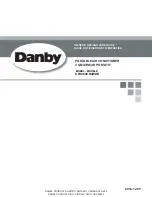
351579-YTS-B-0608
18
Johnson Controls Unitary Products
MILLENNIUM
®
SEQUENCE OF OPERATION
OVERVIEW
The Millennium
®
Simplicity
®
control has comprehensive rule
sets to respond to heat and cool calls, provide anti-shortcycle
and other safeties, date / time clock, and other features making
the programmable thermostat unnecessary. The Millennium
®
Simplicity
®
extends on the rules of the Synthesys digital control.
With an attached (optional) Room Sensor, the control provides
calls for heating and cooling and occupied override. The control
determines when to start morning warm-up, mechanical
cooling, or heat based on parameter settings in the Millennium
®
Simplicity
®
control, its internal time clock, Occupied and holiday
schedules, the deviation from the setpoints, and the rate of
temperature change.
A separate thermostat cannot determine if an output function is
available. For example, if the belts on the supply fan were to
break, the thermostat would still call for the fan to operate and,
if space conditions require, call for heating or cooling. Logic in
the control prevents undesired operation of heating and cooling
stages, with interlocks and minimum run times. Moreover, the
control can report faults on its digital display or on a network to
a monitoring system.
Control logic is designed such that airflow must be proven before
any heating or cooling stage can operate. Mechanical cooling is
locked out below 40 °F outdoor ambient for all units without head
pressure control. The control provides voltage to energize the
contactors for the supply fan, cooling stages, heating stages, and
options such as the economizer and power exhaust. The
thermostat makes calls for cooling and heating; the
Simplicity
®
control is responsible for executing the rules putting these calls into
action and protecting the unit through appropriate safety devices. If
the Millennium
®
Simplicity
®
senses low voltage, it will hold any
call that energizes a contactor until the voltage is adequate. It will
not alarm for low voltage, but will provide a flash code.
The control also energizes the supply fan and cooling stages
based on external inputs from the thermostat:
• G - Supply Fan
• Y1-1st Stage Cooling
• Y2-2nd Stage Cooling
• Y3-3rd Stage Cooling
• Y4-4th Stage Cooling
Heating stages are controlled based on inputs:
• W1-1st Stage Heating
• W2-2nd Stage Heating
• W3-3rd Stage Heating
The economizer is enabled through settings in the control and
operating conditions, or external BAS calls.
RUN SEQUENCE
The unit operates in one of three modes: Occupied, Unoccupied,
and Recovery (Warm-up / Cool-down). The control allows none,
one, or two separate occupied / unoccupied schedules for each
day of the week, and twenty holidays. In addition to the
programmed schedule, the space sensor allows a single key
press to provide up to a 4-hour unoccupied override into the
occupied mode.
OCCUPIED MODE:
The supply fan operates continuously in
the Occupied and Recovery modes. The thermostat cycles
cooling / heating to maintain the space temperature to the
Occupied setpoints.
Simplicity
®
will enable optional economizer
and power exhaust features.
UNOCCUPIED MODE:
The supply fan operates only with
cooling / heating calls. The economizer is disabled during the
unoccupied mode except when free cooling may be used to
condition the space. Cooling / heating stages are cycled to
maintain the space temperature to the Unoccupied setpoints.
RECOVERY MODE:
A special unoccupied mode that allows
transition to occupied mode. The supply fan operates
continuously and the economizer remains disabled. Instead of
maintaining the unoccupied setpoints, the thermostat ramps the
space temperature toward the occupied setpoints. The
Millennium
®
Simplicity
®
control has an option for the control to
“learn” how long it takes to get the building to the desired
temperature, and adjust its start time to minimize the recovery
time. Refer to the Intelli-Start section.
UNIT CONTROLS SEQUENCE
If the thermostat gives a call for G fan, W heating, or Y cooling,
or the space sensor reading is not within the setpoint range; this
is acted upon by unit control according to the sequence outlined
below. A thermostat must not be connected anywhere but the
appropriate labeled terminals. Direct control of compressors
and heaters is not acceptable.
Abbreviations for various components correspond to the labels
on the wiring diagram.
1.
On a call for the supply fan, voltage at terminal G is acted on
by the control. If the supply fan overload is not tripped, volt-
age goes out from the FAN terminal on the control to either
contactor 5M (Supply Fan Motor Starter) or relay FR (per-
mission-to-run for the Variable Frequency Drive). Power is
applied to the airflow proving switch (APS). If the supply fan
operates correctly (proper rotation), the pressure difference
between the supply fan section and the heating section
increases and APS closes to enable operation.
The air proving switch is monitored by the control 90 sec-
onds after the fan is energized.
The control also monitors the supply fan overload. The
overload circuit is wired directly to the control, not in series
with the fan contactor. If the supply fan overload trips for
longer than 5 seconds, the control will shut down the unit. If
the trip clears within 15 minutes, the unit will log an error
and resume operation. If the overload trips three times in
two hours [or stays tripped longer than 15 minutes], the
control will shut the unit down and report an alarm. In a
VAV unit, the control will shut down the unit if the duct pres-
sure shutdown setpoint is reached or exceeded.
















































